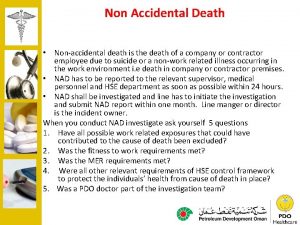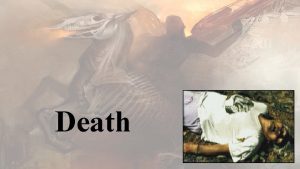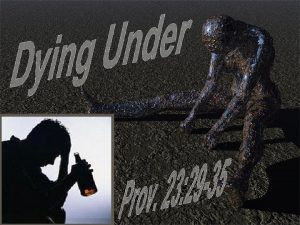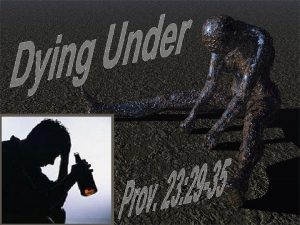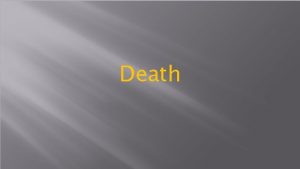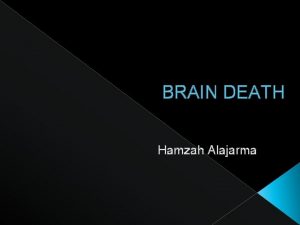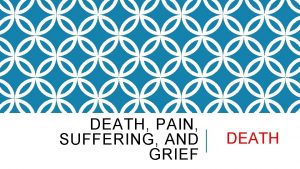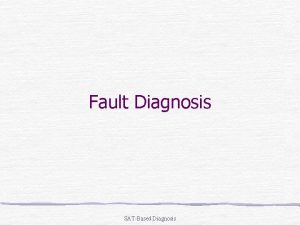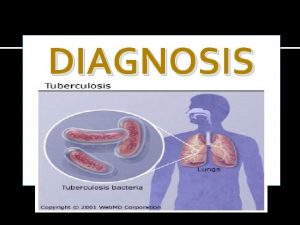Making a diagnosis of death The Diagnosis of














- Slides: 14

Making a diagnosis of death

The Diagnosis of Death Can you define death, and how do you diagnose it? Death has been defined as the irreversible loss of the capacity to breathe combined with the irreversible loss of the capacity for consciousness 1. These capacities reside within the brainstem In most deaths, loss of brainstem function occurs as a result of cardiac arrest and the cessation of blood flow to the brain. This leads to ischaemic and infarction of the vital brainstem structures necessary for life. However in approximately 1000 patients per year, brainstem death occurs in the presence of a beating heart. Death may be diagnosed either by demonstrating the absence of cardiac and respiratory activity for a period sufficient to produce ischaemic damage to the brainstem, and then performing simple and limited tests of brainstem function or, in those rare cases of primary brain damage with a functionng heart and lungs, by performing ‘brainstem death tests’.

How to Diagnose Death by Cardiovascular Criteria Preconditions: The first step in diagnosing death is to confirm the existence of certain ‘pre-conditions’ Firstly it should be established from the available history that the patient suffered simultaneous onset of apnoea and unconsciousness in the absence of a circulation. This may be difficult if the event was unwitnessed, however you should use the best evidence available and your clinical judgement. Secondly you should establish one of the following three conditions: • The individual is not for CPR (if they are for CPR, then you should consider starting resuscitation!) or • Attempts at CPR have failed (for instance, at the end of a ‘crash’ when CPR has been abandoned) or • Life sustaining treatment has been withdrawn (for instance, when the patient is approaching the end of their life and it has been agreed in advance that aggressive treatment is no longer appropriate. Arguable a DNACPR form should have aslo been filled in when this decision was made)

How To Diagnose Death By Cardiovascular Criteria (2) The Tests The patient should be observed for the absence of a central pulse on palpation and the absence of heart and breath sounds on auscultation 1 for a minimum of 5 minutes 2 • 5 minutes is long enough to confirm that the ischaemic damage that is occuring in the brain is sufficient and permanent. It doesn’t matter if you think that the heart stopped some time ago, you still need to confirm that the patient is asystolic for five minutes of continuous observation!!! After 5 mins of continuous cardiorespiratory arrest, confirm that the brainstem has been damaged by examining the patient for the absence of all three of the following: • pupillary light reflexes (with a pen-torch, as you would in a normal neurological examination) • corneal reflexes (by gently brushing the cornea with a swab- a living patient would screw up their eye) and • motor response to supra-orbital pressure (again, a living patient would grimace or exhibit some other motor response). Notes: 1. In hospital settings you may, if available, use monitoring devices to augment your five minutes of observation: • asystole on continuous ECG monitoring • absence of pulsatile flow on direct arterial pressure monitoring • the absence of contractile activity on echocardiography. 2. Any observed cardiac or respiratory activity during this period of observation should prompt a further 5 minutes observation from when this cardiac or respiratory activity stops again. • This is not uncommon, particularly at the end of crash calls when there is often ‘agonal’ breathing

On completion of these test, the patient is diagnosed dead. The time of death is when the tests are completed, not when the patient was found to have no pulse

Brainstem Death What are the criteria for brainstem death? 6

The Diagnosis of Brainstem Death Diagnosing brainstem death is a specialist field, and can only be carried out if appropriate experience is available. The tests are done by two clinicians, at least one of whom must be a consultant. These patients will necessarily be on ICU as their respiratory function is entirely dependent on external mechanical ventilation The process is similar to confirming cardiovascular death. First a series of preconditions are established, and secondly the patient is tested. To diagnose brainstem death, the patient is tested twice.

The Diagnosis of Death by Brainstem Death Criteria Preconditions Firstly, there should be no doubt that the patient’s condition is due to irreversible brain damage of known aetiology • This may be trauma, ischaemic damage, or any other condition that can cause sufficient brain damage, but the diagnosis must be known Secondly, any potentially reversible causes of coma should be excluded. . . • Depressant Drugs (such as drugs taken in overdose, or thse used as sedation on ICU) • Blood tests for these drugs may be useful • Hypothermia- (core temperature less than 34 o. C mimic brainstem death as the patient becomes completely unresponsive- but hypothermia is potentially reversible) • Metabolic/Endocrine disturbance • • mean arterial pressure >60 mm. Hg normocarbia and normoxia serum sodium between 115 and 160 mmol/L serum potassium >2 mmol/L serum phosphate >0. 5 mmol/L serum magnesium <3 mmol/l glucose should be 3 -20 mmol/L Also, testing should not occur in the presence of a, a, Thyroid storm, myxoedema coma and Addisonian crisis should be excluded.

Also, any alternative causes of apnoea must be excluded- these include the presence of neiromuscular blocking drugs (as used in anaesthesia), or a high cervical cord injury

The Diagnosis of Brainstem Death The Tests Absence of brainstem reflexes. . . The pupils are fixed and do not respond to light (cranial nerves II, III) There is no corneal reflex (V, VII) The oculo-vestibular reflexes are absent (V, VIII) No motor responses within the cranial nerve distribution by stimulation of any somatic area (VII) No motor response within the cranial nerve or somatic distribution in response to supraorbital pressure (V, VII) No cough reflex to bronchial stimulation or gag response to pharyngeal stimulation (IX, X)

The Diagnosis of Brainstem Death The apnoea test The process for testing the respiratory response to hypercarbia should be the last brainstem reflex to be tested and should not be performed if any preceding component demonstrates brainstem activity 1. Ensure that the patient has normal oxygen saturations throughout- they should be pre-oxygenated by setting their ventilator to 100% Oxygen for a few minutes before testing 2. The test is primarily completed by documenting the absence of respiratory function given an appropriate stimulus. This stimulus is a high arterial CO 2 concentration. The first step in achieving this is to reduce the ventilatory minute volume (remember, these patients are all fully ventilated) to allow the CO 2 to slowly rise. 3. Once the arterial CO 2 (confirmed by blood gas analysis) is >6 k. Pa, the patient is disconnected from the ventilator in order to render them apnoeic 4. Oxygenation is maintained by ‘mass flow’, essentially attaching the patient’s et tube to a Water’s anaesthetic circuit which is in turn attached to 100% Oxygen 5. The patient is observed for any respiratory activity 6. If no activity is observed after five minutes a further blood gas is performed to ensure that the arterial CO 2 has risen by at least 0. 5 k. Pa. If it has, then the patient has ‘passed’ the apnoea test. 7. Reconnect the ventilator and establish normal ventilation again

The tests are then repeated, in full, by the same clinicians. The patient is diagnosed as brainstem dead on the completion of the second set of tests.

The Diagnosis of Brainstem Death Additional notes * In patients with chronic carbon dioxide retention, or those who have received intravenous bicarbonate, aim for a mild acidaemia by allowing the Pa. CO 2 to rise above 6. 5 k. Pa to a point where the p. H is <7. 40. Adult criteria for brainstem death testing may be used in children over 2 months of age. Those performing testing should not have, or be perceived to have, any conflict of interest. Neither doctor should be a member of the transplant team. Although death is not confirmed until the second set of tests has been completed, the legal time of death is that of the first set of tests. A comprehensive neurological examination is not always possible e. g. in the patient with extensive maxillofacial injuries and brainstem death cannot be diagnosed on clinical testing alone. In such cases, ancillary tests such as CT angiography may facilitate diagnosis.

The Diagnosis of Death Summary Although the diagnosis of death may be based on either cardiovascular or neurological criteria, there is one unifying concept of death in the UK- that the patient is irreversibly unresponsive, and irreversibly apnoeic, and that this is due to brainstem damage (whether it is caused by isolated brain injury or cardiorespiratory arrest) Cardiovascular criteria will be appropriate for the majority of patients. The absence of a circulation, observed for a continuous period of 5 minutes combined with the irreversible onset of apnoea and unconsciousness following either unsuccessful resuscitation or a decision not to attempt resuscitation. Following an observed 5 minute period of continuous cardiorespiratory arrest, the absence of pupillary light reflexes, corneal reflexes and a motor response to supra-orbital pressure establishes that the brainstem has been irreversibly damaged and that death has occurred. Brainstem death is a rare but important phenomena. Testing for brainstem death occurs on an intensive care unit and follows a strict set of guidelines.
 Define forensic pathology
Define forensic pathology Perbedaan diagnosis gizi dan diagnosis medis
Perbedaan diagnosis gizi dan diagnosis medis Medical diagnosis and nursing diagnosis difference
Medical diagnosis and nursing diagnosis difference Second phase of nursing process
Second phase of nursing process Medical diagnosis and nursing diagnosis difference
Medical diagnosis and nursing diagnosis difference Independent nursing interventions
Independent nursing interventions What is inference
What is inference War making and state making as organized crime
War making and state making as organized crime Tư thế ngồi viết
Tư thế ngồi viết Voi kéo gỗ như thế nào
Voi kéo gỗ như thế nào Thẻ vin
Thẻ vin Thể thơ truyền thống
Thể thơ truyền thống Các châu lục và đại dương trên thế giới
Các châu lục và đại dương trên thế giới Từ ngữ thể hiện lòng nhân hậu
Từ ngữ thể hiện lòng nhân hậu Diễn thế sinh thái là
Diễn thế sinh thái là















